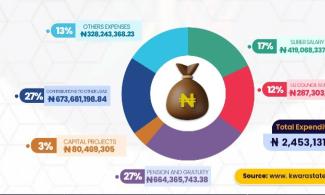
Data retrieved from the Kwara State Government website has shown how the state government diverted 27 per cent of funds allocated to Kaiama Local Government Area from the federal government to other LGAs in the state.
The data obtained showed that of the total income of ₦2.475 billion received by the LGA in 2021, a whooping ₦674 million was deducted and diverted to other LGAs.
This is despite Kaiama LGA lacking basic amenities like clean water, electricity, functional primary health centres and access to quality education.
Kaiama LGA is under the administration of the Transition Implementation Committees (TICs) which has been declared illegal by the Appeal Court in 2022. The TIC supervised the affairs of the local government and the spending of its funds.
The breakdown of the LGA income for the year 2021 according to the state government shows that while 90% (₦2,211,464,420) of the income came from the Federal Government through statutory allocation and Value Added Tax (VAT); 4% (₦91,885,647) of the income came from the 10% Internally Generated Revenue (IGR) shared to the 16 LGAs from KWIRS, under the law. The total independently-generated revenue by Kaiama LG accounted for only 1% (₦35,663,906) of its income in the year 2021; and 6% (₦136,903,186) of its income for the year came from other sources including non-oil revenue, exchange gain difference, forex equalization fund, ecological fund, among others.
Further details show that out of the revenue, a total sum of ₦2.453 billion was spent.
56% (₦1,370,737,482) was spent on the salary of SUBEB teachers, LG Council staff salaries, and pension and gratuities; 13% (₦328,243,368) was spent on the Council overhead and other administrative entities, including subvention to traditional councils, parastatals, etc.
A tiny fraction of 3% (₦80,469,305) of the total revenue was invested in the economic and social condition of the people while 27% (₦673,681,199) was deducted from the funds of Kaiama LG to cater for the needs of ailing LGs in the state, including Asa, Moro, Ilorin East, Ilorin South, Ilorin West, and Irepodun LGs.
Barr. Yusuf Abdulkadir Nafanwona, Director, Investigation and Public Petition (Kwara North) of Elites Network for Sustainable Development (ENetSuD), chided the state government for diverting funds meants for the development of Kaiama LGA.
Barr. Nafanwona noted that Kaiama LGA is one of the LGAs in dire need of social development in the state as identified by ENetSuD in its latest needs assessment projected conducted under its Citizens Enlightenment and Mobilization Program (CEMP).
He said: “ENetSuD imagines how the sum of ₦673,681,199 deducted from the funds of Kaiama LG would have addressed many infrastructural gaps in its various communities, if the LGs have been given financial and administrative autonomy to operate themselves without the interference of the State government.
“In the recent needs assessment conducted across 150 communities in Kamaia LG under its Citizens Enlightenment and Mobilization Program (CEMP), ENetSuD identified the following needs of the communities in the LG: 42 communities had no water facility, and thus, no access to potable water, 106 communities had damaged boreholes that needed to be repaired to have access to potable water, 45 communities had no electrification facility, and thus, no access to electricity, 146 communities needed transformers and/or solar streetlights, 37 communities need primary schools, 104 communities need secondary schools, 48 communities’ schools needed more classrooms, 13 communities had dilapidated classrooms in their shared schools, 121 communities had no access easy to health center, 150 communities needed grading, drainage, construction of their roads, or culverts, 150 communities needed agricultural support, 150 communities needed artisan empowerment, 11 communities needed a GSM network.”
ENetSuD urged the state government to “ensure full financial and administrative autonomy of the Local Governments so that the Councils can look inward to enhance their potentials that will lead to self-sufficiency”.
The group also called for an end to the deduction of an LGA’s fund to service the needs of other LGAs to enable each LGA to solve its problems with its potential and available resources.